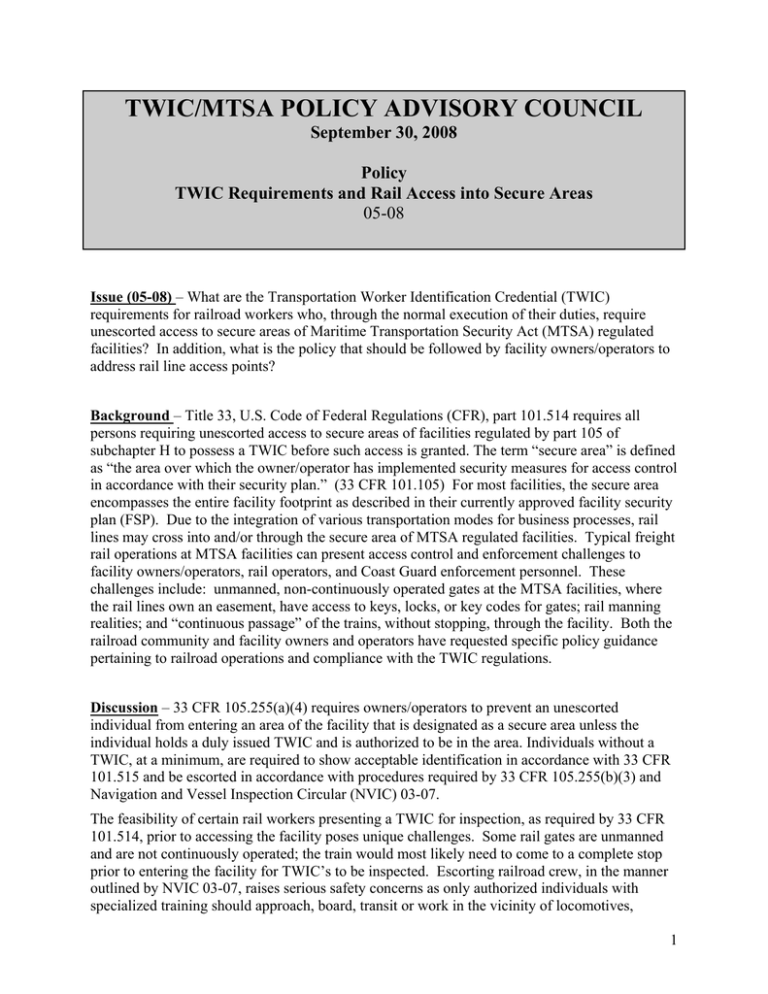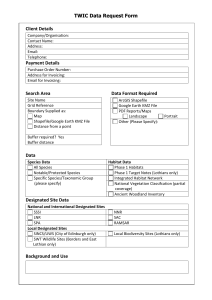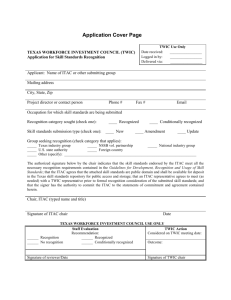twic/mtsa policy advisory council
advertisement

TWIC/MTSA POLICY ADVISORY COUNCIL September 30, 2008 Policy TWIC Requirements and Rail Access into Secure Areas 05-08 Issue (05-08) – What are the Transportation Worker Identification Credential (TWIC) requirements for railroad workers who, through the normal execution of their duties, require unescorted access to secure areas of Maritime Transportation Security Act (MTSA) regulated facilities? In addition, what is the policy that should be followed by facility owners/operators to address rail line access points? Background – Title 33, U.S. Code of Federal Regulations (CFR), part 101.514 requires all persons requiring unescorted access to secure areas of facilities regulated by part 105 of subchapter H to possess a TWIC before such access is granted. The term “secure area” is defined as “the area over which the owner/operator has implemented security measures for access control in accordance with their security plan.” (33 CFR 101.105) For most facilities, the secure area encompasses the entire facility footprint as described in their currently approved facility security plan (FSP). Due to the integration of various transportation modes for business processes, rail lines may cross into and/or through the secure area of MTSA regulated facilities. Typical freight rail operations at MTSA facilities can present access control and enforcement challenges to facility owners/operators, rail operators, and Coast Guard enforcement personnel. These challenges include: unmanned, non-continuously operated gates at the MTSA facilities, where the rail lines own an easement, have access to keys, locks, or key codes for gates; rail manning realities; and “continuous passage” of the trains, without stopping, through the facility. Both the railroad community and facility owners and operators have requested specific policy guidance pertaining to railroad operations and compliance with the TWIC regulations. Discussion – 33 CFR 105.255(a)(4) requires owners/operators to prevent an unescorted individual from entering an area of the facility that is designated as a secure area unless the individual holds a duly issued TWIC and is authorized to be in the area. Individuals without a TWIC, at a minimum, are required to show acceptable identification in accordance with 33 CFR 101.515 and be escorted in accordance with procedures required by 33 CFR 105.255(b)(3) and Navigation and Vessel Inspection Circular (NVIC) 03-07. The feasibility of certain rail workers presenting a TWIC for inspection, as required by 33 CFR 101.514, prior to accessing the facility poses unique challenges. Some rail gates are unmanned and are not continuously operated; the train would most likely need to come to a complete stop prior to entering the facility for TWIC’s to be inspected. Escorting railroad crew, in the manner outlined by NVIC 03-07, raises serious safety concerns as only authorized individuals with specialized training should approach, board, transit or work in the vicinity of locomotives, 1 railcars and railroad tracks. In addition to safety issues, attempting to conduct an escort during railroad operations could detract from the owner/operator and rail crew’s ability to observe potential illegal train riders. Carving out the rail line(s) from the facility footprint and/or running fencing along rail lines is likely not feasible. There are two primary types of railroads that service MTSA facilities: long-haul (Class I) and short line (Class II and Class III). The nature of those types affects the personnel assigned to the individual trains, and therefore the likelihood of their possessing a TWIC. Class II and Class III railroads have fewer employees, a more concentrated or local area of operations, and are most likely already familiar with the security requirements at the facilities they service. Class I railroads are large freight operators which generally cover greater distances, have significantly larger numbers of employees who are often assembled at remote (i.e. not in the general vicinity of maritime ports or TWIC enrollment centers) crewing locations, and interface with multiple facilities and yards across the U.S. Currently, seven Class I and over 500 Class II and Class III freight carriers operate in the U.S. Clearly, the most desirable scenario is for all railroad personnel to possess a TWIC, either while on the train or being brought to the MTSA facility to join a train. Coast Guard Headquarters personnel have been working with representatives from both types of railroads and MTSA facility representatives on TWIC enrollment issues. In addition, the Coast Guard has taken advantage of one of its advisory committees, the National Maritime Security Advisory Committee (NMSAC), to obtain recommendations concerning TWIC rail policy. Policy—Coast Guard National Policy: It is the Coast Guard’s position that, due to the unique aspects of railroad operations that can impact security at MTSA facilities, all railroad crew servicing secure areas of a MTSA facility should possess a TWIC. The Coast Guard recommends railroads view a “MTSA facility crew” as similar to other job qualification prerequisites, such as remote control locomotive operations and territory qualification requirements. Escorting and Monitoring Railroad Crew: While the regulations allow escort and monitoring accommodation that meets NVIC 03-07 for non-TWIC possessing transportation workers, any accommodation must provide an equivalent level of security, and be captured in the approved FSP. Enforcement, by Captains of the Port, should be directed at ensuring this equivalency. In most cases equivalency may be met as follows: • In lieu of railroad crew presenting TWIC’s for visual examination prior to accessing a MTSA facility in accordance with 33 CFR 101.514, their company’s local or regional office/scheduling coordinator could contact the MTSA facility prior to arrival and provide information on the TWIC status of that train’s crew. If all crew possess a valid TWIC, no further action would be required by the train operator and MTSA facility operators may permit the train to enter the facility without any further checking of crew TWICs. For trains providing advanced notice that all crew possess a TWIC, only periodic spot checking of TWIC by facility security personnel and COTP personnel is expected. All spot checks should be coordinated with the FSO to ensure adequate safety of personnel. • If any member of the train crew does not possess a TWIC, the escorting arrangement for those members would need to be approved by the MTSA facility owner/operator, documented as part of the FSP, and approved by the cognizant COTP. This could 2 include checking to ensure all members of the crew have their identification (as required by 33 CFR 101.515) before the train enters the facility. • In preparing procedures for acceptable escort and monitoring of the non-TWIC train crew member(s) a front - of - train TWIC holder, back - of - train non-TWIC holder will generally not qualify as an acceptable arrangement for a locomotive moving multiple railroad cars due to the length of the train and the nature of the work associated with operations. Escorting and monitoring procedures must include the ability to quickly notify facility security personnel if an escorted individual is engaged in activities other than those for which the escorted access was granted. It is also recommended that any non-TWIC crew member(s) remain in the immediate vicinity of the train while in secure areas of a MTSA regulated facility. Both the facility and rail crew are expected to monitor for illegal train riders. • Trains on “continuous passage” through a facility, with proper monitoring, do not have to stop in order to present TWIC’s for visual inspection, but the crew would still need to obtain TWICs and the railroad company’s local or regional office/scheduling coordinator should also provide an arrival schedule including confirmation that the crew possesses valid TWICs in order to achieve an equivalent level of security. If the train does stop within a secure area of a MTSA regulated facility, the policy discussion in the previous paragraph applies. The facility FSP should describe the means to be used to monitor trains in “continuous passage,” which could include closed-circuit video, notification of when the train enters/leaves the facility, or any other method that ensures that the facility security officer, owner, or operator would be able to respond quickly if the train stops. Responsibilities - Coast Guard Captains of the Port: All COTPs should continue outreach to railroads (and their personnel) in their COTP Zone, encouraging enrollment in the TWIC program, and explaining the Coast Guard’s positions as outlined above. It is the Coast Guard’s policy that significant scrutiny will be applied in evaluating the facility security plan’s escort and monitoring provisions for train crews to ensure the security standards for access control in 33 CFR part 105 are being maintained. However, COTPs should allow unique train gate access control provisions in FSPs, provided such an equivalency is demonstrated. Facility monitoring plans for trains on “continuous passage” should also be evaluated prior to FSP approval. Working with FSO’s and railroad safety personnel, COTPs will conduct spot checks of train crews for possession of TWICs while the train and/or crew is within secure areas of the facility. Appropriate enforcement action will follow discovery of a violation of the TWIC provisions of 33 CFR part 105, or the FSP. These violations would be considered a breach of security. Facility owners/operators: Facility owners/operators should work closely with security personnel from the railroads that service or cross their facility’s secure areas. Security measures for access control, as it relates to rail line access points should be stated in procedures to be incorporated into the facility’s security plan. In order to provide an equivalent level of security for unmanned gates, facility owners/operators could request railroads servicing their facility to provide the facility with the schedule and the crew’s TWIC status. The facility owner/operator should describe in the FSP the plan for periodically validating TWIC possession of train crews and escort/monitoring/response procedures for non-TWIC possessing crewmembers. Trains that pass through facilities, but do not stop for cargo operations (continuous passage), could be handled by allowing the train to pass through the facility without a visual inspection of the 3 crew’s TWICs if the train operator provides the facility with advance notice, the facility or train crew monitors the passage of the train to ensure no one gets on or off, and the train does not stop unexpectedly. Railroad operators: In addition to communicating directly with MTSA facility owners/operators regarding TWIC, escorting and other access control requirements, railroad operators should enroll personnel in the TWIC program that may be assigned to trains that service or cross MTSA facilities. This will serve to enhance security of the marine transportation system and railroad operations in addition to minimizing potential down time in freight operations as a result of TWIC escort/monitoring/enforcement activities. 4

